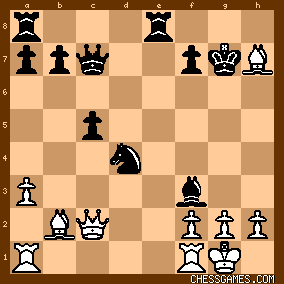| keypusher: Najdorf pays tribute to Bronstein in his note to 16.Qxc5: <Without doubt, Bronstein is currently the most ambitious and tenacious of grandmasters. His own Soviet colleagues esteem him to the highest degree; they "adore" him for his prodigious talents and the inexhaustible wealth of ideas that pour out of every minute of his games. Although we ourselves fall victim many times to his overflowing fantasy, he is in our opinion the player who most "shakes the board," making it come alive and turning the chess struggle into an emotional spectacle for the public. As commentators, we can only suffer and work desperately to uncover his profound ideas and thereby show them to the reader. At this moment in the game, Bronstein thought for an hour and a quarter before deciding to take the pawn. What was it he saw during that time? Nothing less than these variations: 15.e5 Bxf3 16.exf6 Nxd4 17.Bxh7+ Kh8 18.fxg7+ Kxg7 19.Bb2 
click for larger view19....Qf4 with the following continuations:
(a) 20.gxf3? Re5! 21.Bxd4 cxd4 threatening ...Rg5+ and ...Rh5; (b) 20.Qf5 Qxf5 21.Bxf5 Bc6;
(c) 20.Qxc5 Kxh7 21.Qxd4 Qxd4 22.Bxd4 with an extra pawn but also opposite-color bishops and a high probability of a draw. Or even better, 19....Qe5 (in place of ...Qf4) 20.Bxd4 (if 20.gxf3 Nxc2 21.Bxe5+ Kxh7) 20...cxd4 21.gxf3 (not 21.Qf5 Qxf5 22.Bxf5 Be2 and the d-pawn advances) 21....Rh8 22.Qe4 Qg5+ 23.Qg4 (not 23.Kh1 Rxh7 24.Rg1 Rxh2+! 25.Kxh2 Rh8+ 26.Qh4 Rxh4#) 23....Qxg4+ 24.fxg4 Rxh7 25.Rad1 Rd8 26.Rd3, draw. After so much analysis, Bronstein decides on ...another line of play(!) likewise very complicated, with the hope of better prospects. Such is the character of this formidable fighter.> One nice surprise from getting Najdorf's tournament book -- it has definitely deepened my appreciation of Bronstein as a player. | 




































